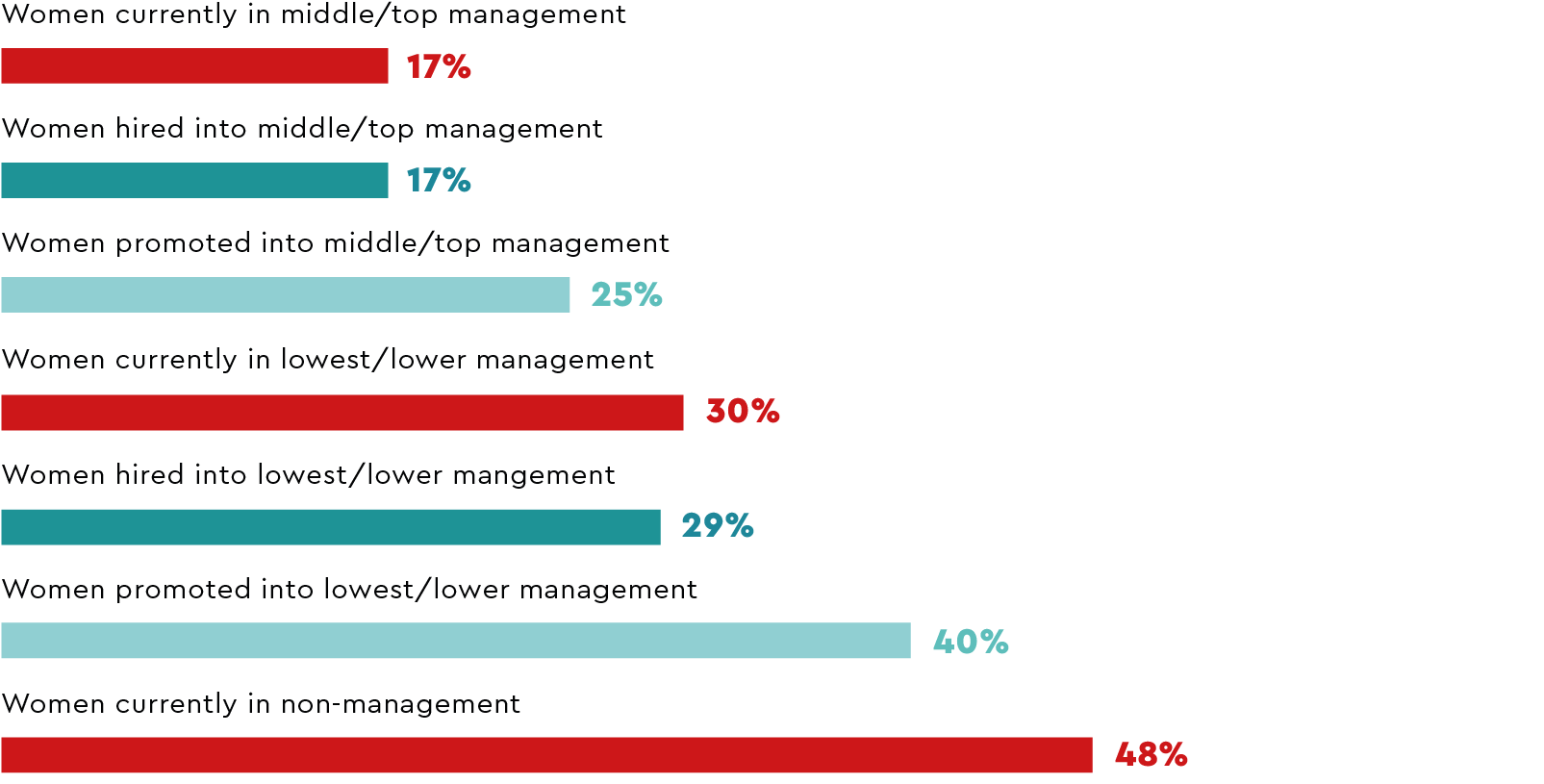In the Banking industry, women are highly underrepresented in management compared to the diverse potential at the base. At 12% in top management, there are considerably fewer women in management than in the full sample of all GIR companies (17%). However, at 48% in non-management, non-management employees are very balanced regarding gender diversity (compared to 44% when looking at the full sample of all GIR companies), which indicates that the Banking industry has a promising, gender-diverse talent base. The Banking industry also has a considerable influx of young talent – over 50% of all new female hires are 30 years or under, whereas for men, this is true for only 42%. To make the best use of this influx of young female talent, the Banking industry needs to make significant changes to its sustainable pipeline management.
Where do banking organizations lose women on the way to the top? In lowest management, there are 40% women, and in lower management, there are only 26%, making the transition from lowest to lower management a key obstacle put in the career paths of women. This means women are not well-represented in positions with personnel responsibility, i.e. the kinds of positions that can provide the sort of visibility and responsibility to propel employees all the way to the top. Only 27% of all positions in lowest management (compared to 39% of positions in lower management) come with personnel responsibility, so the female managers are less often people managers.

Banks insufficiently utilize their internal talent pipeline to increase the share of women in management. While 48% of non-management employees are female (the talent base), women receive only 33% of promotions in lowest and lower management. At a more granular level, women are particularly underrepresented in promotions from lowest to lower management. Though they make up 40% of lowest management, their share in promotions to lower management is only 32%. This percentage should be 40% if women were promoted proportionally. This strengthens the hypothesis that women are underrepresented in the kinds of “springboard positions” in lowest management that are likely to lead to advancement. This point is where the talent pipeline is particularly leaky.
Similar trends persist when it comes to promotions in middle and top management. While promotions at these levels contribute to increasing the very low share of women at the top, the talent base of lowest and lower management is still significantly underutilized.
Despite the unbalanced internal development patterns, recruitment is even more underutilized to advance women to the top. Throughout all management levels, the banking industry succeeds better at advancing women’s careers by promoting women internally rather than hiring externally.
Especially between 31 and 40, women are promoted and hired into key springboard positions (lowest and lower management) at considerably lower rates than their male counterparts. This is particularly striking when it comes to hiring, yet when it comes to promotions into lowest and lower management, men are still promoted at almost twice the rate as women in this key age group.
Looking at the typical talent when it comes to both promotions and management hires, they are overwhelmingly male, Swiss, between 31 and 40 years old, and work full-time.
While full-time work is the norm for men and women in banking in middle and top management, men and women differ in their average employment percentages at lower management levels. While only 13% of men in lowest and lower management work part-time, 42% of women do. If full-time is expected to attain a top management position, the pool of men who will be seen as promising talents is considerably larger than women.
In the 31-to-40 age bracket, many employees in Switzerland start their families. Laws and policies, as well as gender stereotypes in society surrounding parenthood, still incentivize women to be the primary caretakers. The difference between men’s and women’s employment percentage in lowest and lower management is most significant at around age 35. In Banking, this difference is greater than in other industries (such as the MEM industry or Pharma/Med-tech), where women’s and men’s employment rates stay more consistent around this age and women face fewer hurdles to middle and top management.
Compared to other industries, the difference in employment percentage between lowest and lower management (for women) is particularly large. It seems that women must increase their employment percentage to rise the ranks (from an average of 86% in lowest management to 90% in lower management and 95% in middle management).
The typical senior manager is older and male: 45% of male senior managers are over 50 years old. The expected wave of baby boomer retirements provides a unique opportunity to diversify management. After all, while women’s share in management is 27%, among 51–60-year-olds, it is only 21%. Retiring of “the old guard” will, on its own, contribute to a slight leveling of the gender distribution in management.
To really change the face of leadership, the Banking industry has its work cut out; 41% of female managers are 40 or below. So, to make sure these diverse talents make it to the top, a cultural shift in terms of sustainable talent management (internally and externally) and inclusive culture is critical.
Though banks are underutilizing their internal pipelines, they are even more so underutilizing their external talent pipelines. Well-qualified women exist – but must be reached, attracted, retained, and developed (you can find some tips about sustainable talent management here). How?